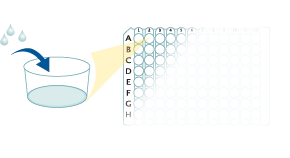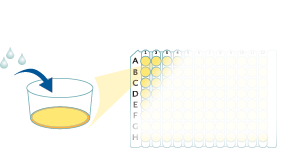Human FGF acidic/FGF1 Quantikine ELISA Kit Summary
Product Summary
Precision
Cell Culture Supernates, Urine
| Intra-Assay Precision | Inter-Assay Precision | |||||
|---|---|---|---|---|---|---|
| Sample | 1 | 2 | 3 | 1 | 2 | 3 |
| n | 20 | 20 | 20 | 40 | 40 | 40 |
| Mean (pg/mL) | 208 | 485 | 766 | 204 | 477 | 761 |
| Standard Deviation | 7.6 | 21.8 | 22.9 | 15 | 29.3 | 48.7 |
| CV% | 3.7 | 4.5 | 3 | 7.4 | 6.1 | 6.4 |
Serum, EDTA Plasma, Heparin Plasma
| Intra-Assay Precision | Inter-Assay Precision | |||||
|---|---|---|---|---|---|---|
| Sample | 1 | 2 | 3 | 1 | 2 | 3 |
| n | 20 | 20 | 20 | 40 | 40 | 40 |
| Mean (pg/mL) | 179 | 441 | 749 | 178 | 433 | 713 |
| Standard Deviation | 8.3 | 31.8 | 17.6 | 15 | 36.3 | 61 |
| CV% | 4.6 | 7.2 | 2.3 | 8.4 | 8.4 | 8.6 |
Recovery
The recovery of FGF acidic spiked to levels throughout the range of the assay in various matrices was evaluated.
| Sample Type | Average % Recovery | Range % |
|---|---|---|
| Cell Culture Media (n=4) | 105 | 93-113 |
| EDTA Plasma (n=4) | 102 | 93-109 |
| Heparin Plasma (n=4) | 97 | 92-110 |
| Serum (n=4) | 98 | 89-108 |
| Urine (n=4) | 99 | 89-108 |
Linearity
Scientific Data
Product Datasheets
Preparation and Storage
Background: FGF acidic/FGF1
FGF acidic, also known as FGF-1, ECGF, and HBGF-1, is a secreted mitogen that stimulates the proliferation of all cells of mesodermal origin and many cells of neuroectodermal, ectodermal, and endodermal origin. It plays a number of roles in development, regeneration, and angiogenesis. FGF acidic is released extracellularly as a disulfide-linked homodimer and is stored in complex with extracellular heparan sulfate. The association of FGF acidic with heparan sulfate is a prerequisite for its subsequent interaction with FGF receptors. Internalized FGF acidic can translocate to the cytosol and to the nucleus. Intracellular FGF acidic functions as a survival factor by inhibiting p53 activity and proapoptotic signaling.
Assay Procedure
Refer to the product- Prepare all reagents, standard dilutions, and samples as directed in the product insert.
- Remove excess microplate strips from the plate frame, return them to the foil pouch containing the desiccant pack, and reseal.
- Add 150 µL of Assay Diluent to each well.
- Add 50 µL of Standard, control, or sample to each well. Cover with a plate sealer, and incubate at room temperature for 2 hours on a horizontal orbital microplate shaker.
- Aspirate each well and wash, repeating the process 3 times for a total of 4 washes.
- Add 200 µL of Conjugate to each well. Cover with a new plate sealer, and incubate at room temperature for 2 hours on the shaker.
- Aspirate and wash 4 times.
- Add 200 µL Substrate Solution to each well. Incubate at room temperature for 30 minutes on the benchtop. PROTECT FROM LIGHT.
- Add 50 µL of Stop Solution to each well. Read at 450 nm within 30 minutes. Set wavelength correction to 540 nm or 570 nm.





Citations for Human FGF acidic/FGF1 Quantikine ELISA Kit
R&D Systems personnel manually curate a database that contains references using R&D Systems products. The data collected includes not only links to publications in PubMed, but also provides information about sample types, species, and experimental conditions.
9
Citations: Showing 1 - 9
Filter your results:
Filter by:
-
The EGFR-STYK1-FGF1 axis sustains functional drug tolerance to EGFR inhibitors in EGFR-mutant non-small cell lung cancer
Authors: C Eggermont, P Giron, M Noeparast, H Vandenplas, P Aza-Blanc, GJ Gutierrez, J De Grève
Oncogene, 2022-07-15;13(7):611.
Species: Human
Sample Types: Cell Lysates
-
Validation of a Double-Sandwich Enzyme-Linked Immunoassay for Pharmacokinetic Study of an rh-aFGF Hydrogel in Rat Skin and Serum
Authors: Q Hui, R Yang, C Lu, J Bi, L Li, J Gong, L Zhang, Z Jin, X Li, X Wang
Front Pharmacol, 2020-05-19;11(0):700.
Species: Human
Sample Types: Tissue Homogenates
-
Glioblastoma Cell Resistance to EGFR and MET Inhibition Can Be Overcome via Blockade of FGFR-SPRY2 Bypass Signaling
Authors: EK Day, NG Sosale, A Xiao, Q Zhong, B Purow, MJ Lazzara
Cell Rep, 2020-03-10;30(10):3383-3396.e7.
Species: Human
Sample Types: Cell Culture Supernates
-
Individuality in FGF1 expression significantly influences platinum resistance and progression-free survival in ovarian cancer.
Br. J. Cancer, 2012-09-18;107(8):1327-36.
Species: Human
Sample Types: Cell Culture Supernates
-
Functional analysis of the chemokine receptor CCR3 on airway epithelial cells.
Authors: Beck LA, Tancowny B, Brummet ME, Asaki SY, Curry SL, Penno MB, Foster M, Bahl A, Stellato C
J. Immunol., 2006-09-01;177(5):3344-54.
Species: Human
Sample Types: Cell Culture Supernates
-
Humoral and cellular factors responsible for coronary collateral formation.
Authors: Sherman JA, Hall A, Malenka DJ, De Muinck ED, Simons M
Am. J. Cardiol., 2006-08-31;98(9):1194-7.
Species: Human
Sample Types: Plasma
-
Quantitative assessment of growth factors in reaming aspirate, iliac crest, and platelet preparation.
Authors: Herrmann S, Green J, Weber T, Scharfenberger A
Bone, 2006-07-25;39(5):1156-63.
Species: Human
Sample Types: Tissue Homogenates
-
IL-17 enhances the net angiogenic activity and in vivo growth of human non-small cell lung cancer in SCID mice through promoting CXCR-2-dependent angiogenesis.
Authors: Numasaki M, Watanabe M, Suzuki T, Takahashi H, Nakamura A, McAllister F, Hishinuma T, Goto J, Lotze MT, Kolls JK, Sasaki H
J. Immunol., 2005-11-01;175(9):6177-89.
Species: Human
Sample Types: Cell Culture Supernates
-
Alpha-tocopheryl succinate inhibits malignant mesothelioma by disrupting the fibroblast growth factor autocrine loop: mechanism and the role of oxidative stress.
Authors: Stapelberg M, Gellert N, Swettenham E, Tomasetti M, Witting PK, Procopio A, Neuzil J
J. Biol. Chem., 2005-05-05;280(27):25369-76.
Species: Human
Sample Types: Cell Culture Supernates
FAQs
No product specific FAQs exist for this product, however you may
View all ELISA FAQsReviews for Human FGF acidic/FGF1 Quantikine ELISA Kit
Average Rating: 4.5 (Based on 2 Reviews)
Have you used Human FGF acidic/FGF1 Quantikine ELISA Kit?
Submit a review and receive an Amazon gift card.
$25/€18/£15/$25CAN/¥75 Yuan/¥2500 Yen for a review with an image
$10/€7/£6/$10 CAD/¥70 Yuan/¥1110 Yen for a review without an image
Filter by:







